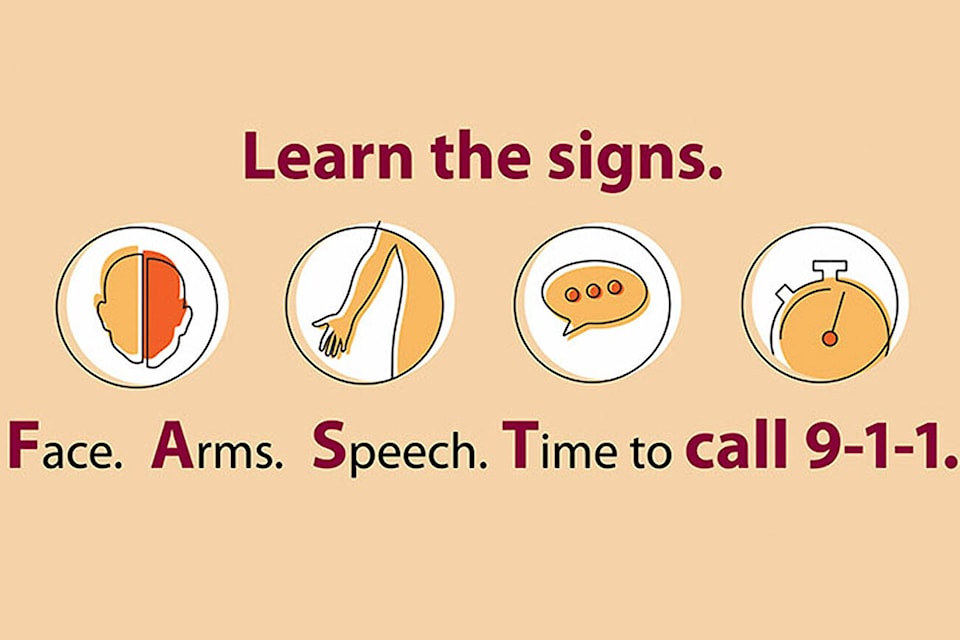We’ve kinda been on pause because of Covid-19, but strokes did not go on pause. Eschia, take it easy eh!
World Stroke Day is Oct. 29, so I’m gonna talk about strokes today.
One summer my dad called me around 4 a.m. in the morning. He said “I tried to get out of bed and my legs were like spaghetti.” He said he was disoriented and the only phone number he could remember was mine so he called me.
I asked if his chest was sore and he said no. I asked if he could move his arms and legs and he yes, he just couldn’t stand. I thought stroke or heart attack, so I told him he was going to be ok and that I was going to call the ambulance and would come right over.
When I got to my dad’s place, the ambulance was just arriving. He had managed to mostly dress himself, so we got him off to the hospital quickly.
We found out my dad had had a stroke. We were lucky. First, his phone was right by his bed, or who knows how long he would have laid there without medical assistance. Second, I had a key to his door, so we didn’t have to break in.
What is a stroke?
A stroke occurs when something stops the blood flowing to our brain, and the brain is damaged.
If the stroke happens in the left side of the brain, it causes things like right side paralysis; speech and language problems; slow behavioral style; and memory loss.
A stroke in the right side of the brain causes things like paralysis on the left side; vision problems; quick, inquisitive behavioral style; and memory loss.
If the stroke happens in the brain stem, we can be left unable to speak or have any movement below the neck. Whoa.
How do I recognize a stroke has happened? Look for FAST!
Face: is it drooping?
Arms: can you raise both?
Speech: is it slurred or jumbled?
Time to call 911 right away!
There are also less common signs, like blurred or double vision; sudden severe headache, usually with other signs; numbness – usually on one side of the body; and balance problems.
Risk factors
Things that increase our risk of having a stroke are called risk factors, and most of us have at least one risk factor. Mama mia.
We can control many risk factors, including unhealthy diet, being physically inactive, being too over weight, smoking, stress, and abusing drugs and/or alcohol.
Risk factors we can’t control include being male or female. For instance a woman’s risk of stroke increases after menopause.
Also, the older we get the greater the risk of having a stroke. And, if a close relative had a stroke when they were young, this increases the risk.
Additionally, people of Indigenous, African or South Asian heritage, are likely to have high blood pressure, diabetes or other risk factors at a younger age.
Conditions we have can also be a risk. For instance, high blood pressure and cholesterol are major risk factors for stroke. So, get your blood pressure and cholesterol checked regularly. Oh ya.
Having diabetes, irregular heart rhythm, and disorders of the mind that affect our mental ability also increase our chances of stroke.
Prevention is key
It’s very important to develop habits to reduce our risk, but don’t try to change everything at once. Tackle one or two things at a time.
First, eat a healthy diet. Try to have 7-10 servings of fruit and vegetables every day. And eat foods that are high in fibre like wild and brown rice, oatmeal, vegetables, fruit, beans and lentils.
It’s very important to eat protein every day, and it is found in meat, fish, poultry, dairy products, nuts and legumes.
Eat a minimum amount of salt, sugar and fat, and cook meals from scratch, using unprocessed foods. This is very important because producers usually remove nutrients and add salt and sugar to processed foods. Totally uncool.
Staying active is important, so move, move, move. For instance, try to go for a 30 minute walk every day, shovel snow, cut wood, walk the dog, rake leaves, or play a sport.
Don’t stop there; get ideas on being more active from people like fitness experts. And for heavens sake, stop smoking and abusing alcohol and drugs.
Finally, reduce stress in your life by identifying what stresses you and how to manage the stressors. You should also learn lifelong habits to maintain a healthy weight.
When my dad had his stroke, the doctor said he would never walk without a cane, but he worked hard in physiotherapy and at home and he never did use one. And, he lived another 15 years, dying at the age of 87 from a heart attack.
I went to visit him when he was still in hospital, and soon a nurse came in. She said, “do you want to go to the bathroom Fred? I’ll help you.” My dad quickly jumped up.
She put her arm around his waist and said, “Put your arm around my neck.” He happily complied. When he came out of the bathroom, again she put her arm around his waist and he put his arm around her neck.
Just when they got to the bed, a second nurse came in and said, “Fred, you know you’re not supposed to get up.” My dad smiled happily and said, “Oh ya!”
The first nurse said, “Fred, you old bugger! Why didn’t you tell me.” Hahahhahahahaha my dad was always good for a laugh.
Remember, strokes do not take a pause but prevention is key.
